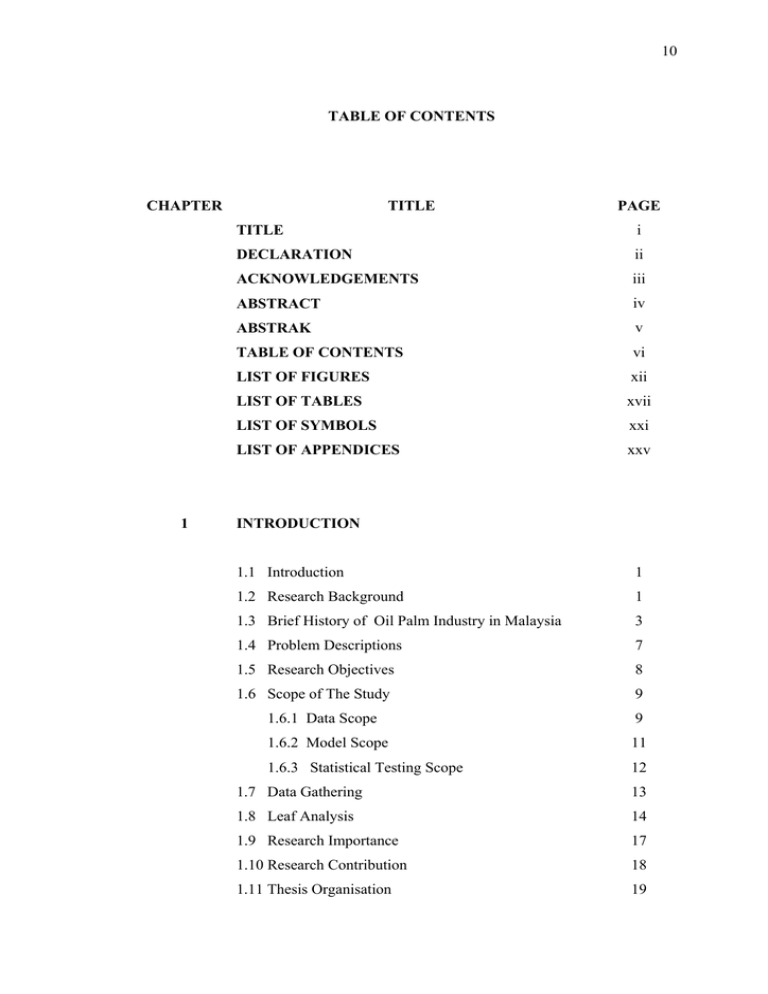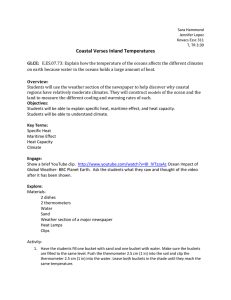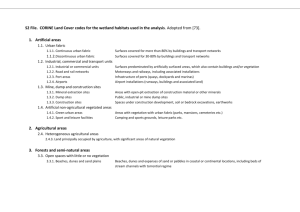10 i ii
advertisement

10 TABLE OF CONTENTS CHAPTER 1 TITLE PAGE TITLE i DECLARATION ii ACKNOWLEDGEMENTS iii ABSTRACT iv ABSTRAK v TABLE OF CONTENTS vi LIST OF FIGURES xii LIST OF TABLES xvii LIST OF SYMBOLS xxi LIST OF APPENDICES xxv INTRODUCTION 1.1 Introduction 1 1.2 Research Background 1 1.3 Brief History of Oil Palm Industry in Malaysia 3 1.4 Problem Descriptions 7 1.5 Research Objectives 8 1.6 Scope of The Study 9 1.6.1 Data Scope 9 1.6.2 Model Scope 11 1.6.3 Statistical Testing Scope 12 1.7 Data Gathering 13 1.8 Leaf Analysis 14 1.9 Research Importance 17 1.10 Research Contribution 18 1.11 Thesis Organisation 19 11 2 REVIEW OF THE LITERATURE 2.1 Introduction 21 2.2 Oil Palm Yield Modelling 21 2.3 Nonlinear Growth Model 27 2.4 Application of Neural Network Modelling 30 2.4.1 Neural Network in Science and Technology 31 2.4.2 Neural Network in Economy 32 2.4.3 Neural Network in Environmental and 34 Health 35 2.4.4 Neural Network in Agriculture 2.5 Response Surface Analysis 2.6 3 37 38 Summary RESEARCH METHODOLOGY 3.1 Introduction 43 3.2 Data Analysis 43 3.3 Modelling 45 3.3.1 Nonlinear Growth Models 3.3.1.1 Nonlinear Methodology 3.3.2 Regression Analysis 3.3.2.1 Least Squares Method 45 47 51 51 3.3.3 Robust M-Regression 53 3.3.4 Neural Networks Model 55 3.3.4.1 Introduction to Neural Network 56 3.3.4.2 Fundamentals of Neural Network 57 3.3.4.3 Processing Unit 58 3.3.4.4 Combination Function 58 3.3.4.5 Activation Function 59 3.3.4.6 Network Topologies 62 12 3.3.4.7 Network Learning 64 3.3.4.8 Objective Function 65 3.3.4.9 Basic Architecture of Feed-Forward Neural Network 3.3.5 Response Surface Analysis 66 72 3.3.5.1 Introduction 73 3.3.5.2 Response Surface: First Order 73 3.3.5.3 Response Surface: Second Order 76 3.3.5.4 Stationary Point 77 3.3.5.5 Ridge Analysis 79 3.3.5.6 Estimate the standard error of predicted response 3.4 Summary 4 80 81 MODELLING OIL PALM YIELD GROWTH USING NONLINEAR GROWTH MODEL 4.1 Introduction 4.2 The Nonlinear Model 4.3 The Method of Estimation 4.4 Partial Derivatives for The Nonlinear Models 4.5 Results and Discussion 4.6 Conclusion 5 MODELLING OIL PALM YIELD USING MULTIPLE LINEAR REGRESSION AND ROBUST M-REGRESSION 5.1 Introduction 82 84 85 87 93 104 13 5.2 Model Development 105 5.3 Results and Discussion 105 5.3.1 Multiple Linear Regression 107 5.3.2 Residual Analysis for MLR 107 5.3.3 Robust M-Regression 110 5.3.4 Residual Analysis for RMR 115 5.4 Conclusion 116 119 6 NEURAL NETWORK MODEL FOR OIL PALM YIELD 6.1 Introduction 122 6.2 Neural Network Procedure 123 6.2.1 Data Preparation 123 6.2.2 Calculating Degree of Freedom 124 6.3 Computer Application 125 6.4 Experimental Design for Neural Network 129 6.4.1 Experiment 1 131 6.4.2 Experiment 2 131 6.4.3 Experiment 3 132 6.5 Results and Discussion 133 6.5.1 Statistical Analysis 133 6.5.2 Neural Network Performance 138 6.5.3 Residual Analysis 146 6.5.4 Results of Experiment 1 149 6.5.5 Results of Experiment 2 149 6.5.6 Results of Experiment 3 149 6.6 Comparative Study on Oil Palm Yield Modelling 155 6.7 Conclusion 167 14 7 THE APPLICATION OF RESPONSE SURFACE ANALYSIS IN MODELLING OIL PALM YIELD 7.1 Introduction 7.2 Response Surface Analysis 7.3 Data Analysis 7.4 Numerical Analysis 7.4.1 Canonical Analysis for Fertilizer Treatments 7.4.2 Ridge Analysis for Fertilizer Treatments 7.5 Economic Analysis 7.5.1 Profit Analysis 7.6 Conclusion 8 169 169 172 173 174 179 186 187 195 SUMMARY AND CONCLUSION 8.1 Introduction 196 8.2 Results and Discussion 196 8.2.1 Initial Exploratory Study 197 8.2.2 Modelling Using Neural Network 201 8.2.3 Modelling Using Response Surface Analysis 208 8.3 Conclusion 211 8.4 Areas for Further Research 211 REFERENCES 214 Appendices A - U 231 15 LIST OF TABLES TITLE TABLE NO. 1.1 PAGE The optimum value of nutrient balance ratio, NBR for foliar analysis 17 2.1 The summary of the literature reviews in this study 39 3.1 Nonlinear mathematical models considered in the study 50 3.2 Summary of the data set types and research approaches considers in this study 4.1 Partial derivatives of the Logistic and Gompertz and von Bertalanffy growth models 4.2 4.4 87 Partial derivatives of the Negative exponential, Monomolecular, log-logistic and Richard’s growth models 4.3 81 88 Partial derivatives of the Weibull, Schnute and MorganMercer-Flodin growth models 89 Partial derivatives of the Champan-Richard and Stannard 90 growth models 4.5 Parameter estimates of the logistic, Gompertz, negative exponential, monomolecular, log-logistic, Richard’s and Weibull growth models for yield-age relationship 94 16 4.6 Parameter estimates of the MMF, von Bertalanffy, Chapman-Richard and Stannard growth models for yieldage relationship 4.7 Asymptotic correlation for each nonlinear growth models fitted 4.8 95 96 The actual and predicted values of FFB yield, the associated measurement error and correlation coefficient between the actual and predicted values for Logistic , Gompertz, von Bertalanffy, negative exponential, mono molecular and log-logistic growth models 4.9 98 The actual and predicted values of FFB yield, the associated measurement error and correlation coefficient between the actual and predicted values for Richard’s , Weibull, MMF, Chapman-Richard, Chapman-Richard* (with initial) and Stannard growth models 4.10 99 The parameter estimates an asymptotic correlation for von Bertalanffy and Chapman-Richard when an initial growth response data point is added 4.11 The number of iteration and the root mean squares error for nonlinear growth models consider in this study 5.1 119 The regression equation for the inland and coastal station using MNC and NBR as independent variables 5.3 104 The regression equations and R2 values for the inland and coastal areas 5.2 103 Regression equation using robust M-regression for the 114 17 inland and coastal areas 6.1 The F statistics value for ANOVA for different activation functions used for inland area 6.2 137 Mean squares error for training, validation, testing and average of the neural networks model in the inland area 6.6 136 Duncan test for the average of MSE for homogeneous subsets for the inland and coastal areas 6.5 135 The Chi-Square value of MSE testing for the inland and coastal areas 6.4 134 The F statistics value for ANOVA for different activation functions used for the coastal area 6.3 116 138 Mean squares error for training, validation, testing and average of the neural networks model in the coastal area 139 6.7 The correlation coefficient of the neural network model 140 6.8 The MAPE values of the neural network model 141 6.9 The t-statistic values in the training data 152 6.10 The t-statistic values for the test data 155 6.11 The MSE, RMSE, MAE and MAPE for MLR, MMR and neural networks performance for inland 6.12 157 The MSE, RMSE, MAE and MAPE for MLR, MMR and neural networks performance for coastal area 158 18 6.13 The correlation changes from the MLR and MMR models to neural network model 6.14 The performance changes of the MAPE from the MLR and MMR to the neural network model 7.1 175 The eigenvalues and predicted FFB yield at stationary point for each critical fertilizer level in inland area 7.4 174 The average of FFB yield, MSE, RMSE and R2 values for coastal area 7.3 164 The average of FFB yield, MSE, RMSE and R2 values for inland area 7.2 163 176 The eigenvalues, the predicted FFB yield at the stationary points and critical values of fertiliser level for CLD1 and CLD2 stations 7.5 177 The eigenvalues, the predicted FFB yield at the stationary points and critical values of fertiliser level for CLD3, CLD4, CLD5, CLD6 and CLD7 7.6 The estimated FFB yield and fertiliser level at certain radius for stations ILD3 and ILD4 in the inland area 7.7 181 The estimated FFB yield and fertiliser level at certain radii for station ILD7 7.9 180 The estimated FFB yield and fertiliser level at certain radius for stations ILD5 and ILD6 in the inland area 7.8 178 The estimated FFB yield and fertiliser level at certain radii 182 19 for stations CLD1 and CLD2 in the coastal area 7.10 The estimated FFB yield and fertiliser level at the certain radii for stations CLD4 and CLD5 in the coastal area 7.11 198 The RMSE, MAPE and R2 values for the MLR and MMR modeling for the inland and coastal areas 8.3 193 The adequacy of fit measurement used for the nonlinear growth models 8.2 192 The estimated FFB yield and the foliar nutrient composition levels in (%) for the coastal area 8.1 189 The estimated FFB yield and the foliar nutrient composition levels in (%) for inland area 7.15 186 The fertiliser level, average estimated of FFB yield and total profit for the inland and coastal areas 7.14 185 The estimated FFB yield and fertiliser level at the certain radii for station CLD7 in the coastal area 7.13 184 The estimated FFB yield and fertiliser level at the certain radii for stations CLD5 and CLD6 in the coastal area 7.12 183 199 The RMSE, MAPE and R2 values for the MLR and MMR modeling for the coastal area 200 8.4 The F values of the analysis of variance for different activation functions for the inland and coastal areas 8.5 202 The MAPE values and the correlation of the neural network models for the inland and coastal areas 203 20 8.6 The F value of analysis of variance for Experiment 1, 2 and 3 8.7 204 The comparison of the MAPE values and the correlation values among the MLR, MMR and NN models for inland and coastal areas 8.8 The accuracy of the MLR, MMR, NN models and the accuracy changes for the inland area 8.9 209 The fertiliser level, average estimated of FFB yield and total profit for the coastal area 8.12 207 The fertiliser level, average estimated of FFB yield and total profit for the inland area 8.11 207 The accuracy of the MLR, MMR, NN models and the accuracy changes for the coastal area 8.10 205 209 The average estimated of the FFB yield and the foliar nutrient composition levels for the inland and coastal areas 210 21 LIST OF FIGURES TITLE FIGURE NO. 1.1 Annual production of crude palm oil (1975-2003) including Peninsular Malaysia, Sabah and Sarawak 1.2 PAGE 4 Oil palm planted area: 1975 – 2003 (hectare) including Peninsular Malaysia, Sabah and Sarawak 5 1.3 Annual export of palm oil: 1975 – 2003 (in tonnes) 5 1.4 World major producers of palm oil (‘000 tonnes) 6 1.5 World major exporter of palm oil and including reexporting country (*) 1.6 6 Summary of research framework and research methodology used in this study 10 3.1 Data analysis procedure used in this study 44 3.2 FFB yield growth versus time (year of harvest) 46 3.3 Processing unit 58 3.4 Identity function 60 3.5 Binary step function 60 22 3.6 Sigmoid function 61 3.7 Bipolar sigmoid function 61 3.8 Feed-forward neural network 62 3.9 Recurrent neural network 63 3.10 Supervised learning model 65 3.11 Backward propagation 70 3.12 The descent vs. learning rate and momentum 72 4.1 Residual plot for Logistic, Gompertz, von Bertalanffy, Negative exponential, Monomolecular and Log logistic growth models 4.2 100 Residual plot for Richard’s, Weibull, Morgan-MercerFlodin, Chapman-Richard, Chapman-Richard* and Stannard growth models 5.1 The error distribution plots of MLR model in coastal stations 5.2 5.5 112 The error distribution plots of RMR model in inland stations 5.4 111 The error distribution plots of MLR model in inland stations 5.3 101 117 The error distribution plots of RMR model in coastal stations 118 The R2 value for each model proposed for inland area 119 23 5.6 The R2 value for each model proposed for coastal area 6.1 Three layers fully connected neural networks with five input nodes and one output node 6.2 144 The actual and predicted FFB yield for CLD4, CLD5, CLD6 and CLD7 using the NN model 6.10 143 The actual and predicted FFB yield for ILDT, CLD1, CLD2 and CLD3 stations using the NN model 6.9 142 The actual and predicted FFB yield for ILD4, ILD5, ILD6 and ILD7 stations using the NN model 6.8 130 The actual and predicted FFB yield for ILD1, ILD2 and ILD3 stations using the NN model 6.7 129 The three layers fully connected neural networks with nine input nodes and one output node 6.6 128 The correlation coefficient between the actual and predicted value 6.5 128 The mean squares error for training, validation and testing 6.4 125 The early stopping procedure for feed-forward neural network 6.3 120 145 The actual and predicted FFB yield for CLDT using the NN model 146 24 6.11 The error distribution plot of neural network model for the inland stations 6.12 The error distribution plots of neural network model for the coastal stations 6.13 160 Comparison of the MAPE values between MLR, MMR and NN for inland area 6.20 159 The correlation coefficient from the MLR, MMR and NN models for coastal area 6.19 153 The correlation coefficient from the MLR, MMR and NN models for inland area 6.18 153 The MSE values for different levels of the magnitudeoutliers in the test data 6.17 151 The MSE values for different levels of the percentageoutliers in the test data 6.16 150 The MSE values for different levels of the magnitudeoutliers in the training data 6.15 148 The MSE values for different levels of the percentageoutliers in the training data 6.14 147 160 Comparison of the MAPE values between MLR, MMR and NN for coastal area 161 6.21 Comparison of the accuracy of models for inland area 165 6.22 Comparison of the accuracy of models for coastal area 165 25 6.23 The percentage changes of the model accuracy for inland area 6.24 The percentage changes of the models accuracy for coastal area 7.1 166 166 The response surface plots for fertiliser treatments in ILD1 and ILD2 stations in inland and CLD2 and CLD7 stations in coastal area 7.2 171 Data analysis procedure in obtaining the optimum level of fertiliser level and foliar nutrient composition 172 7.3 The fertiliser levels for each station in the inland area 190 7.4 The fertiliser levels for each station in the coastal area 191 7.5 The foliar nutrient composition levels for each station in the inland area 7.6 The foliar nutrient composition levels for each station in the coastal area 7.7 8.1 192 194 Comparison between the N and K fertiliser level needs by oil palm for the coastal and inland areas 194 The factors that contribute to oil palm yield production 213 26 LIST OF SYMBOLS FFB - Fresh Fruit Bunches FELDA - Federal Land Development Authority RISDA - Rubber Industry Smallholders Development Authority SADC - State Agriculture Development Corporations FELCRA - Federal Land Consolidation and Rehabilitation Authority LSU - Leaf Sampling Unit NN - Neural Network MLR - Multiple Linear Regression RMR - Robust M-Regression RSA - Response Surface Analysis MSE - Mean Square Error RMSE - Root Mean Square Error MAPE - Mean Absolute Percentage Error N - Nitrogen P - Phosphorus K - Potassium Ca - Calcium Mg - Magnesium TLB - Total Leaf Basis NBR - Nutrient Balance Ratio CLP - Critical Leaf Phosphorus Concentration MNC - Major Nutrient Component AS - Ammonium Sulphate CIRP - Christmas Island Rock Phosphate KIES - Kieserite 27 LIST OF APPENDICES APPENDIX TITLE PAGE A The list of oil palm experimental stations 231 B The rate and actual value of fertiliser (kg/palm/year) 232 C Summary of macro nutrients needed by plants 234 D The list of paper published from 2001 until Now 236 E The ridge analysis 239 F Nonlinear least squares iterative phase, nonlinear least squares summary statistics and normal probability plot for the nonlinear growth models G 240 The parameters estimate using multiple linear regression for MNC as independent variables for 255 inland area H The parameters estimate using multiple linear regression for MNC as independent variables for 256 coastal area I Normal probability plot of multiple linear regression for the inland area J 257 Normal probability plot of multiple linear regression for the coastal area 258 28 K The parameters estimate using multiple linear regression using MNC and NBR as independent variables for the coastal area L 259 The parameters estimate using multiple linear regression using MNC and NBR as independent variables for the inland area 260 M The Q-Q plot for inland stations 261 N The Q-Q plot for coastal stations 262 O Example of the Matlab programming for neural network application P Graphical illustration for the best regression line fitting for inland stations Q 276 The calculation of total profit (RM) for the inland stations according to each radius U 274 The MSE, RMSE, MAE and MAPE values for each neural network model in the coastal area T 270 The MSE, RMSE, MAE and MAPE values for each neural network model in the inland area S 266 Graphical illustration for the best regression line fitting for coastal stations R 263 278 The calculation of total profit (RM) for the coastal stations in the coastal areas according to each radius 281





